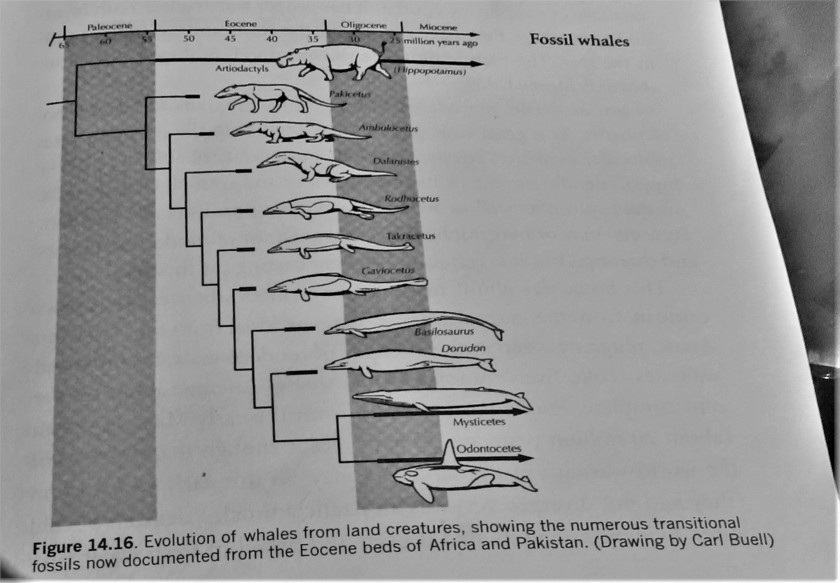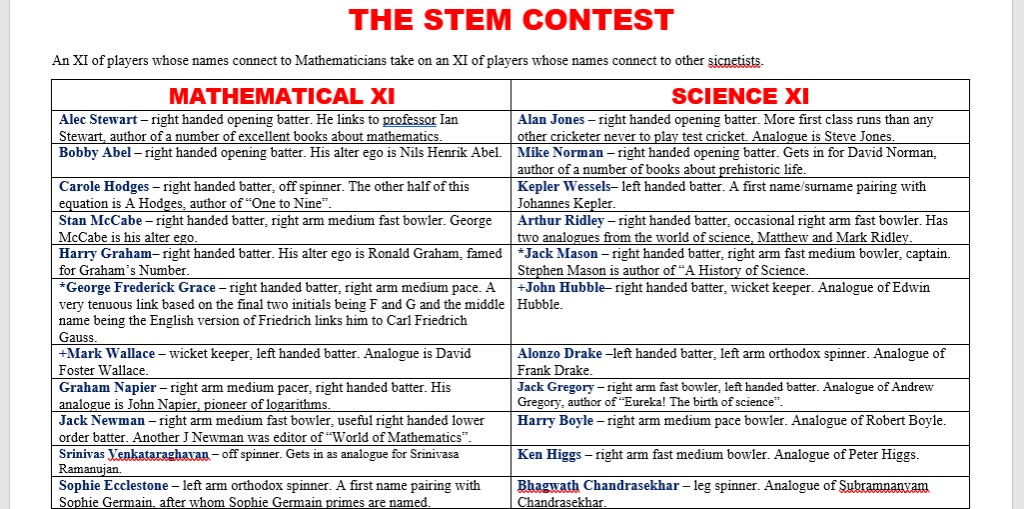INTRODUCTION
Welcome to the latest installment in my all time XI cricket series. Today the focus is on cricketers whose names link to STEM subjects.
MATHEMATICAL XI
- Alec Stewart – right handed opening batter. As I have previously mentioned he averaged 45 for England in this specific role. Undoubtedly his greatest moment as opener came at Barbados in 1994. England had just lost the Trinidad test match, collapsing to 46 all out in pursuit of a target of 194, and nobody had beaten the West Indies at Barbados since 1935. Stewart responded to the challenge with 143 and 118, and England duly won the match.His analogue is Ian Stewart, author of a number of excellent books about mathematics.
- Bobby Abel – right handed opening batter. The first ever to carry his bat through an England innings, and holds the record for carrying his bat through the largest first class innings (Surrey 811 all out v Somerset, Abel 357 not out). His alter ego for this purpose is Norwegian mathematician Niels Henrik Abel.
- Carole Hodges – right handed batter, off spinner. A fine all rounder whose regular batting position this was. Her alter ego is Andrew Hodges, author of a book titled ‘One to Nine’.
- Stan McCabe – right handed batter, right arm medium fast bowler. An Aussie legend of the 1930s, author of three of the greatest test innings ever played – 187 at Sydney in the first match of the 1932-3 Ashes, 189 not out vs South Africa facing a target of over 400, and playing so brilliantly that the SA captain appealed against the light, and 232 not out at Trent Bridge in 1938, when Bradman called his team out on to the balcony on the grounds that they would probably never see anything like this again. George McCabe did some work on the mathematics of lottery wins.
- Harry Graham – right handed batter. A century on test debut at Lords, a feat no repeated at that ground until John Hampshire in 1969. His alter ego is Ronald Graham, he worked out Graham’s number, which is so huge that it could never be written out in full. More about this number and its significance here.
- *George Frederick Grace – the youngest Grace of WG’s generation, he was one of the leading all rounders of the 1870s. A freak illness killed him at the age of 29. I have given him his full name to set the stage for the explanation of an admittedly tenuous piece of linking. His middle name of Frederick is the English version of Friedrich and his surname begins with a G, which is just enough, given who I am linking to to give a nod to Carl Friedrich Gauss, one of the greatest of all mathematicians. Gauss showed his brilliance as a child, when his teacher set the class to add up all the numbers from 1 to 100. The teacher was expecting a long break while the students worked on this task, but Gauss realized that the problem could be viewed as 50 pairs of numbers which summed to 101, in otherwords 50 x 101 = 5,050, and was finished very quickly. Later in his life Gauss correctly calculated the orbit of Ceres and told astronomers where they needed to look with their telescopes to see it again.
- +Mark Wallace – wicket keeper, left handed batter. A very fine player for Glamorgan who never quite managed to attract the attention of the England selectors. His alter ego is David Foster Wallace, author of a biography of Georg Cantor.
- Graham Napier – right arm medium pace bowler, right handed batter. He was better at limited overs cricket than long form, but he did once hit 17 sixes in a first class innings against Surrey. His analogue is John Napier, pioneer of logarithms.
- Jack Newman – right arm fast medium bowler, useful lower order batter. He abd Alec Kennedy carried the Hampshire bowling load together for many years. He is in here as analogue to James Newman who edited a book called ‘World of Mathematics‘.
- Srinivas Venkataraghavan – off spinner. One of the great Indian spin quartet of the 1970s, and later a fine umpire. His analogue is Srinivasa Ramanujan, a great Indian mathematician of the early 20th century.
- Sophie Ecclestone – left arm orthodox spinner. The women these days play very little test cricket, but she has had considerable success in the shorter forms, especially given how young she still is. She is here because she shares a first name with Sophie Germain, a great French mathematician who has a class of prime numbers named in her honour. A ‘Sophie Germain prime‘ is a prime number which when you double it and add one gives another prime. There are Sophie Germain prime sequences, where each number obtained by this process is a prime – one well known example goes 89, 179, 359, 719 and 1439 – 2,879 is not itself a Sophie Germain prime because 5759 is equal to 443 x 13.
This team has a good top five, an all rounder at six, a keeper who can bat, and four varied bowlers. There is a lack of genuine pace, but otherwise the bowling looks respectable.
AN HONOURABLE MENTION
I could also have got the Sophie Germain reference in by picking New Zealand pace bowling all rounder Sophie Devine. I reckoned that selecting the spinner made for a more balanced team.
THE SCIENCES XI
- Alan Jones – right handed opening batter, more first class runs than anyone else who never played test cricket. His analogue is evolutionary biologist Steve Jones.
- Mike Norman – right handed opening batter. Had a long career with first Northamptonshire and then Leciestershire. He owes his place here to David Norman, author of several paleontology books. He has a subversive streak, and carried out a thought experiment in evolution based on the dinosaurs not going extinct, arriving at the conclusion that one particular lineage of dinosaurs might have arrived at a large brained biped 40 million years ago.
- Kepler Wessels – left handed batter. The only player to have scored over 1,000 runs for each of two different countries. His scientific namesake is the one and only Johannes Kepler.
- Arthur Ridley – right handed batter, occasional fast bowler. He shared the largest partnership of the 1878 match between MCC and Australia, 22 with AN Monkey Hornby. At 27-2 in the MCC first innings Frederick Robert Spofforth was called up for a bowl, and took 6-4, causing the last eight wickets to crash for six runs. In the second innings after Australia had eked out a lead of eight Spofforth and Boyle opened, Spofforth taking 4-16 and Boyle 6-3, as MCC crashed for 19, making 18 wickets for 25 runs. He has two namesakes from the world of biology, Matthew and Mark Ridley.
- *Jack Mason – right handed batter, right arm fast medium bowler., captain. A fine record which would have been greater still had he not retired to concentrate on his career as a solicitor at the age of 28. Stephen Mason is the author of “A History of Science.”
- +John Hubble – right handed batter, wicket keeper. Kept for Kent between Frederick Huish and Les Ames. His namesake is the legendary Edwin Powell Hubble.
- Alonzo Drake – left handed batter, left arm orthodox spinner. A remarkable career, ended by World War 1 – in the last two months of his professional career he collected 85 wickets in first class matches and played some crucial innings. His namesake is Frank Drake, creator the Drake Equation, which may ultimately enable the calculation of the likelihood of extraterrestrial civilisations (at the moment the error bars on many of the terms are simply too large for it to of any real value).
- Jack Gregory – right arm fast bowler, left handed batter. In first class cricket he averaged 36 with the bat and 20.99 with the ball, while in test cricket he paid 30 per wicket. He formed one half of test cricket’s first great fast bowling partnership, with Ted McDonald. Skipper Warwick Armstrong deployed them with such ruthlessness that Australia won eight straight matches in 1920 and 1921, before a combination of Phil Mead’s batting and some inclement English weather allowed the last two matches of that series to be drawn.His namesake is Andrew Gregory, author of “Eureka! the birth of science”, a title inspired by the great Archimedes of Syracuse.
- Harry Boyle – right arm medium pace bowler. Yes, the self same Boyle who combined with Spofforth to dismiss MCC for 19 on that famous day in 1878. His namesake is Robert Boyle, famous for Boyle’s law.
- Ken Higgs – right arm fast medium bowler. A successful bowler for first Lancashire and then Leciestershire, including playing for England at one point He gets in here as namFesake to Peter Higgs, of Higgs boson fame (incidentally the word boson for that class of particles derives from Indian scientist Satyendra Bose).
- Bhagwath Chandrasekhar – leg spinner. Among bowlers who never played county championship cricket only Clarrie Grimmett, also a leg spinner, took more first class wickets. His namesake is Subrahmanyan Chandrasekhar, after whom the Chandrasekhar limit (the most mass a white dwarf can have before gravity causes to collapse an form a neutron star) is named.
This side has a respectable top order, genuine all rounders in Hubble, Drake and Gregory and three varied bowlers. Higgs, Gregory, Boyle, Chandrasekhar and Drake looks a good and well balanced bowling unit.
AN HONOURABLE MENTION
Folk whose vision is particular strong in the green and gold regions of the spectrum will be aware of Jim Higgs, a fine leg spinner of the 1970s, and a candidate for Peter Higgs’ namesake. I felt that with one leg spinner and absolutely blown in the glass no 11 already inked in for selection that fast medium bowler Ken was a better pick in terms of balance.
THE CONTEST
This should be a good contest – the general science XI has a slightly better balance to it, and in Jack Gregory the only serious pace available to either side, but the mathematical team is definitely stronger in batting. Also, the fact that Hodges (especially) and McCabe among the the mathematical team’s top batters are genuine bowling options partially makes up for their lack of pace, and at least with Venkataraghavan, Ecclestone and Hodges bowling varieties of spin it is not all going to be workaday medium pace.
LINK AND PHOTOGRAPHS
I have introduced my two teams for today’s STEM contest, but before I sign off, Richard Murphy of Tax Research UK has being running a ‘mythbuster‘ series of posts on his blog, and his latest such takes on the ‘National Debt‘. Now we have reached time for my usual sign off…















